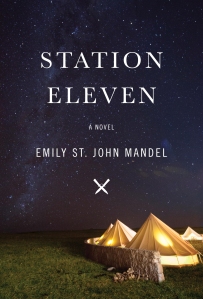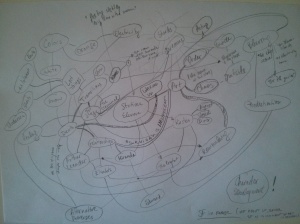 “Dr. Eleven: What was it like for you, at the end?
“Dr. Eleven: What was it like for you, at the end?
Captain Lonagan: It was exactly like waking up from a dream.”
Disclaimer: The review contains some non-trivial spoilers. Though I am quite convinced that the reading of this particular book cannot really suffer from them, proceed at your own risk.
I like to think about Station Eleven as of science fiction in reverse. Where most SF stories conceive of the future as a superstructure built over their past (and somebody’s present), in this one the future looks back toward the past as a dream of wasted miracles and heartbreaking loss. Against the backdrop of a crippled world and through the excruciating prism of art, a thing of poignant beauty is brought together. Because survival is insufficient.
This last sentence – taken from a Star Trek episode and painted over the wagons of a troupe of actors and musicians, The Traveling Symphony. They ply the erstwhile American lands bordering the Great Lakes, performing their Shakespeare and their music. But America is no more, not for twenty years, since the Georgian swine flu almost wiped out humanity.
Station Eleven is not about the apocalypse and its aftermath, though. The event itself is more of a prompt, a setting of the stage where all the important pieces come together in a narrative symphony. A popular post-apocalypse book is mentioned in passing, but no, this one is not about weathering time through wit and daring. Because survival is insufficient.
The novel opens on the stage of a Toronto theater, with the death of one Arthur Leander, a Hollywood star, three times divorcee, at this very moment possessed by King Lear. The artificial snow is falling silently, as the curtain is dropped and as a man from the audience, an ex-paparazzo and to-be CPR technician, is pumping away at Arthur’s chest in an attempt to save him. Outside, real snow is covering Toronto in a shroud of whiteness, a beautiful evening that will mark an end to the known world. Twenty years later, a girl who played Lear’s kid daughter in that same production “walked in sandals whose soles had been cut from an automobile tire, three knives in her belt.” Kirsten remembers little of the time before the collapse, but that past will become focal for her in a way that she will never fully comprehend.
Nor can anybody really understand the complex web of human interactions that makes our world go on. But this unknowability is not the novel’s point either. Rather, it is art, memory, human connection and the act of waking up, it is the struggle against unknowability. The theater stage is aptly chosen as the focus of all these themes:
“Not quite a room, Jeevan thought now, looking around the stage. It was too transitory, all those doorways and dark spaces between wings, the missing ceiling. It was more like a terminal, he thought, a train station or an airport, everyone passing quickly through.”
Later on in the book, an airport terminal becomes a locus for a few hundred survivors and a repository for the old world’s memories. Transitory, doorless, like the grand leveling of the collapse, like individual death, or like the end of a relationship – a recurrent motif in the novel. There is a scene where the dog of Arthur Leander’s first wife watches a dinner party from outside the glass wall of a dining room, the wife, Miranda, watching it from inside. Once she exits and joins the dog in its observation, she realizes the theater going on inside, that her relationship with Arthur is done.
The fixation upon rooms is consistent, for the people of the past and for those of the future, who ponder only theoretically and occasionally the idea of living in a proper house. Rooms—physical, virtual, metaphorical—are places where people wither in isolation, or where they meet others and form new relationships. There is a moment in the story when a certain repetitive argument between two characters is likened to a room where these people gather to share their friendship. Station Eleven is littered throughout with these intense fusions of the abstract and the particular, made possible by the shattering event of the collapse. As if the world has been smashed with a hammer and only shards of it remain, to be reordered and interpreted through art and empathy, to be reinvented together with language itself. The non-linear structure of the novel forces the different parts to reflect one another, to seek out harmony – textual, interpersonal, chromatic, whatever kind that can capture the interwovenness of things.
Ultimately, the novel deals with loss. Not just the dramatic, large-scale loss that is the event of the collapse, but loss at all levels:
“The last time I ate an ice-cream cone in a park in the sunlight. The last time I danced in a club. The last time I saw a moving bus. The last time I boarded an airplane that hadn’t been repurposed as living quarters, an airplane that actually took off. The last time I ate an orange.”
“… all of the small details that comprise a morning, a life”
The loss of things and moments and memories, forgetting and remembering, the things that comprise a character, a person. The characters of Station Eleven are one of the most beautiful things about it. In a reality in which so much has been lost or is about to be lost, these people are introduced sparingly, as if every word must count for ten taken from a novel where the world doesn’t end. In a line or three you become close to these people, so losing them, or living through loss through them, is all the more painful. Just look at how they enter the stage:
“He was the second violin and a secret poet, which is to say no one in the Symphony knew he wrote poetry except Kirsten and the seventh guitar.”
“Dieter walked a little ahead of the other actors, murmuring to his favorite horse. The horse, Bernstein, was missing half his tail, because the first cello had just restrung his bow last week.”
“Here in the parking lot in a pressing heat wave, patches of sweat under the arms of his T-shirt, knee-torn jeans, he was perfectly credible as a king.”
And many more wonderful psychological vignettes that come to life through intense interaction and dramatic ordering. Another implicit theme is precisely the opposition between order and chaos, mirrored in the recurrent underlying opposition of outside and inside. It is not a simple binary one, however. None of the polar opposites are assigned a final positive or negative value, as chaos gives birth to new beginnings but also to heartbreak, and excessive order is shown to lock people in rooms, to introduce dangerous fragility and to generate meaningless corporate drivel and high-falutin. It is in this recurrent play with the kernel of images and signs that the novel is most reminiscent of Shakespeare, not in the explicit references to his works. Which is truly Shakespearean in spirit, to insist that deep meaning arises out of the collective language and shared being – much more powerfully and reliably than it does from the deliberate actions of single individuals.
The glue holding it all together is of course art. Аrtfulness—as opposed to artsiness—applied to everything in life, and incidentally to the construction of this particular novel, woven through and through with the effort of a determined artist. Much in the same way, Miranda devotes her every spare moment to the creation of her life’s work – the graphic novel “Station Eleven”, a tale of an artificial moon that has escaped the Solar System through a worm whole and carries the human refugees fleeing from an alien invasion. Some of them hide in the Undersea, waiting for their lives to begin anew and contemplating surrender, others are actively trying to forge a new future for humanity. At several points Miranda latches onto physical details in the surrounding environment and incorporates them in her work, and through these renditions some kind of order and memory are preserved through time.
The graphic novel as a symbolic fulcrum, as well as the traveling symphony, powerfully leverage the idea of intermixing modalities and memories, of blurring otherwise crisp borders. The use of colors in the book highlights this quality in an especially strong way:
“A wash of violent color, pink and streaks of brilliant orange, the container ships on the horizon suspended between the blaze of the sky and the water aflame, the seascape bleeding into confused visions of Station Eleven, its extravagant sunsets and its indigo sea. The lights of the fleet fading into morning, the ocean burning into sky.”
Blurring and acting and art – all processes that necessarily omit and destroy information, but ultimately, if done right, might lead to salvation. The concept is contrasted sharply with fanatically religious visions of predestination that paint the world into highly ordered schematics. Art in the end is interpreted as a constant and lethal struggle against meaningless, mechanically linear, ghostly existence. Art battles death and courts it all the same; it is a matter of death and life. “If you remember your lines in questionable territory, you’ll be fine onstage.”
Station Eleven is not story-driven, nor is it character-driven, though it is excellent in terms of both. Its energy and essence spring from this deeper belief in the redeeming value of trying to be fully human, whatever that may mean. It is deeply emotional, but in a quiet, meditative way. Its language and structure are precise rather than ebullient, and naturally such is the aftertaste it leaves. It looks with melancholy toward our present from the vantage point of a wrecked world, where the landscape is less cluttered with people. Its characters dream of space stations and starships, of alternative universes where people can connect instantly with one another, on its pages an inventor pedals madly at a bicycle to bring an old laptop back to life, secretly hoping of finding the mythical Internet. Where science fiction illuminates the inscrutable now through the miracles of the future, Station Eleven does it by going forward and peering back at the miracles of the present. Its alternative universe – an instrument to aid us to rearrange and understand, and remember.
“We traveled so far and your friendship meant everything. It was very difficult, but there were moments of beauty. Everything ends. I am not afraid.”
